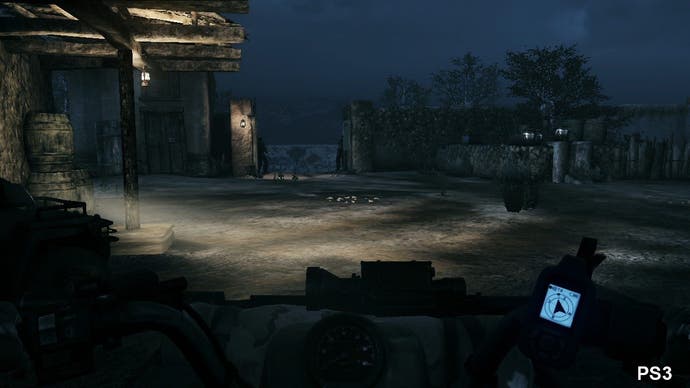Face-Off: Medal of Honor
Tiers before bedtime.
| - | Xbox 360 | PlayStation 3 |
|---|---|---|
| Disc Size | 5.5GB | 5.64GB (11.6GB with MOH: Frontline) |
| Install | 5.5GB (optional) | 2746MB (mandatory) |
| Surround Support | Dolby Digital | Dolby Digital, 5.1LPCM, DTS |
Technology plays a role of enormous importance within the first-person shooter genre. Design decisions in creating the game engine dictate more than just the look of the game - they're crucial in how it plays. Medal of Honor suffers somewhat compared to its competitors as the foundations for both single- and multiplayer modes were basically air-lifted in by Epic and DICE respectively, creating something of a "second hand" experience to what should have been one of EA's biggest and most important games of the year.
Perhaps then it's no surprise that finding something memorable or unique about Medal of Honor is so difficult. This is no problem for its rivals: Call of Duty is defined by its aim to supply ultra-low latency controller response, foregoing advanced rendering techniques in favour of a game that runs extremely smoothly and puts the player firmly in control. Battlefield: Bad Company 2 on the other hand halves the frame-rate but makes up for it with one of the most advanced engines on the market today: wide open levels, terrain deformation, a stunning destruction model, and ultra-detailed artwork only really scratch the surface of what the Frostbite engine is capable of.
Both are modern warfare based titles, but they are very individual games that have forged their own identities in what must surely be the most competitive area of the market, and many of the core things they do brilliantly are all intimately related to the strengths of the game engines that run them.
In playing Medal of Honor, it's difficult to ascertain exactly what it is that the developers wanted to achieve with this game over and above creating the slick, enjoyable shooter that it undoubtedly is. In putting together this Face-Off, it seems that it is the PC version that has the answers, but this is clearly a console-orientated production and we'll be looking at the PS3 and Xbox 360 releases first and foremost.
Medal of Honor is literally a game of two halves, so to begin with, let's take a look at a selection of scenes from the single-player campaign mode. Powered by Unreal Engine 3, the middleware has a reputation for providing nigh-on identical graphics on both HD consoles. Use the full-screen button to get full 720p resolution, or click the EGTV link for a larger window. Alternatively, there's a triple-format comparison gallery to check out.
As per the norm with UE3 titles, we see native 720p resolution on both platforms and an almost exact parity in terms of visual features. There is some small evidence that 2x MSAA is included on the Xbox 360 version, but in common with many UE3 titles it seems that the work on this is carried out relatively early in the rendering process, with subsequent processing killing off much of the edge-smoothing. Certainly, the overall impression when looking at both games (and even the PC version with AA enabled) is that they are effectively running without anti-aliasing at all.
Differences in the visual make-up of the game are slight - unnoticeable for most part - but here, for example, we can see obviously lower-resolution ground texture on the PlayStation 3 version of the game. Hardly earth-shattering stuff, and it's exactly the kind of artwork you'd trim back if you really did have memory issues.


However, this is small beer - a technical curiosity at most - and the overall conclusion is that Danger Close has done a good job in getting some decent visuals out of UE3, which are essentially like-for-like on both console platforms.
We know that historically the UE3 tech has favoured the Xbox 360, with smoother frame-rates and a small basket of additional graphical effects available to developers. However, there's little doubt that the PS3 rendition of the Epic middleware has improved in recent times and effects-wise the two engines are now basically a match. The comparison movie proves that there's effectively nothing between the two games from a graphical perspective, but a difference in performance level is still clearly apparent. We saw it in Enslaved and we're seeing it in the Medal of Honor campaign mode too.
Typical for console UE3, the game operates at a capped 30 frames-per-second, but will drop v-sync in order to maintain fluidity in visual feedback when the engine is under stress. It is the nature of those drops that is an issue. There's are certain hotspots in many of the game's campaign levels that really flummox the PS3, compounding screen-tear with some heavy drops in frame-rate.
It's difficult to understand quite why the PS3 version has these problem areas where performance really suffers. If you run a comparison of cut-scenes it holds its own rather well and often maintains v-sync in areas where the exact same scene will cause tearing on the 360. It suggests that there are specific rendering tasks where each platform has its own strengths and weaknesses, but this does not seem to translate over to the game itself.






